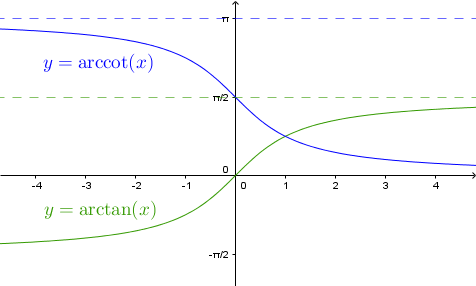Arkustangens und Arkuskotangens
Arkustangens und Arkuskotangens sind mathematische Funktionen. Sie sind die Umkehrfunktionen des Tangens bzw. des Kotangens und damit Arkusfunktionen. Da der Tangens periodisch ist, wird zur Umkehrung der Definitionsbereich von Tangens auf dem Intervall beschränkt. Beim Arkuskotangens erfolgt eine Beschränkung auf
Definition

Eigenschaften
Zwischen Arkustangens und Arkuskotangens besteht folgende Beziehung:
- .
| Arkustangens | Arkuskotangens | |
|---|---|---|
| Definitionsbereich | ||
| Wertebereich | ||
| Periodizität | keine | keine |
| Monotonie | streng monoton steigend | streng monoton fallend |
| Symmetrien | Ungerade Funktion: | Punktsymmetrie zu |
| Asymptoten | für | für für |
| Nullstellen | keine | |
| Sprungstellen | keine | keine |
| Polstellen | keine | keine |
| Extrema | keine | keine |
| Wendepunkte |
Spezielle Werte
Reihenentwicklung
Die Taylorreihe des Arkustangens lautet:
Diese Reihe konvergiert genau dann, wenn . Der Arkustangens ist allerdings auf ganz definiert.
Die Reihenentwicklung kann zur näherungsweisen Berechnung der Zahl verwendet werden: Die einfachste Formel ist der Spezialfall , die Leibniz-Formel
Die kompliziertere Formel
verwendete John Machin[1] , um die ersten 100 Nachkommastellen von zu berechnen.
Die Taylorreihe des Arkuskotangens lautet:
Funktionalgleichung
Die Arkustangenswerte über lassen sich aus den Werten zwischen 0 und 1 ableiten:
Das geht auch mit Werten für :
Umkehrfunktionen
- und
Ableitungen
Arkustangens:
Arkuskotangens:
- .
Stammfunktionen
Arkustangens:
Der Arkustangens spielt eine wesentliche Rolle bei der symbolischen Integration von Ausdrücken der Form
- .
Ist die Diskriminante positiv oder Null, so kann man eine Stammfunktion mittels Partialbruchzerlegung bestimmen. Ist die Diskriminante negativ, so kann man den Ausdruck durch die Substitution
in die Form
bringen; eine Stammfunktion ist also
- .
Eine Stammfunktion des Arkustangens selbst ist
Arkuskotangens:
Näherungsweise Berechnung
Es gelten folgende Näherungen:
- für ,
- für .
1 John Machin, 1680-1751, englischer Astronom und Mathematiker
Wer die erhabene Weisheit der Mathematik tadelt, nährt sich von Verwirrung.
Leonardo da Vinci
Copyright- und Lizenzinformationen: Diese Seite basiert dem Artikel
Arkustangens und Arkuskotangens
aus der frеiеn Enzyklοpädιe Wιkιpеdιa
und stеht unter der Dοppellizеnz
GNU-Lιzenz für freie Dokumentation und
Crеative Commons CC-BY-SA 3.0 Unportеd
(Kurzfassung).
In der Wιkιpеdιa ist eine
Listе dеr Autorеn
des Originalartikels verfügbar.
Da der Artikel geändert wurde, reicht die Angabe dieser Liste für eine lizenzkonforme Weiternutzung nicht aus!
Anbieterkеnnzeichnung: Mathеpеdιa von Тhοmas Stеιnfеld
• Dοrfplatz 25 • 17237 Blankеnsее
• Tel.: 01734332309 (Vodafone/D2) •
Email: cο@maτhepedιa.dе